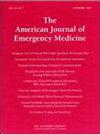Comparison of rapid nucleic acid amplification tests and rapid antigen tests for influenza in the emergency department
IF 2.2
3区 医学
Q1 EMERGENCY MEDICINE
引用次数: 0
Abstract
Background
Influenza is a seasonal epidemic that poses significant health risks. Early antiviral treatment is recommended, making rapid and accurate diagnostic testing essential. Although rapid antigen tests (RATs) are widely used, they have limited sensitivity. In contrast, rapid nucleic acid amplification tests (NAATs) may offer improved diagnostic accuracy. This study compares the performance of a rapid NAAT and RAT for influenza in the emergency department.
Methods
This prospective comparative study evaluated the rapid NAAT (ID NOW Influenza A&B, Abbott) and the RAT (BD Veritor System for Rapid Detection of Flu A + B, BD). Paired nasopharyngeal swabs were tested as point-of-care tests. Discordant results and agreement between the two tests were evaluated.
Results
A total of 453 patients were analyzed from December 2023 to February 2025. Mean age was 50.6 ± 20.6 years; 239 (52.8 %) were male. Influenza was detected in 166 (36.6 %) patients. Mean time from symptom onset to testing was 32.4 ± 62.1 h. Rapid NAAT-positive but RAT-negative cases were significantly more frequent (P < 0.001), supporting the higher sensitivity of the rapid NAAT. Cohen's kappa coefficient between tests was 0.750 (95 % CI 0.685–0.815, P < 0.001). This suggests systematic differences in sensitivity rather than random disagreement. Among patients tested within 48 h of symptom onset, discordance remained significant (P < 0.001).
Conclusion
In patients with suspected influenza in the emergency department, although rapid NAAT and RAT demonstrated good agreement, the cases that tested positive by the rapid NAAT but negative by the RAT were significantly more frequent. This suggests that rapid NAAT may be a more suitable diagnostic tool in the emergency department, as rapid NAAT can help avoid false negatives, enable timely antiviral treatment, and improve clinical decision-making within the critical treatment window.
急诊科流感快速核酸扩增试验与快速抗原试验的比较
背景:流感是造成重大健康风险的季节性流行病。建议进行早期抗病毒治疗,因此必须进行快速和准确的诊断检测。尽管快速抗原试验(rat)被广泛使用,但它们的灵敏度有限。相比之下,快速核酸扩增试验(NAATs)可能提供更高的诊断准确性。本研究比较了急诊科流感快速NAAT和RAT的性能。方法:本前瞻性比较研究评估了快速NAAT (ID NOW Influenza A&B, Abbott)和RAT (BD Veritor System for rapid Detection of Flu A + B, BD)。配对鼻咽拭子作为即时检测进行检测。评估了两个测试之间的不一致结果和一致性。结果:从2023年12月至2025年2月共分析了453例患者。平均年龄50.6±20.6岁;239例(52.8%)为男性。166例(36.6%)患者检出流感。从症状出现到检测的平均时间为32.4±62.1 h。快速NAAT阳性而RAT阴性的病例明显多于阴性(P结论:在急诊科疑似流感患者中,尽管快速NAAT和RAT表现出良好的一致性,但快速NAAT阳性而RAT阴性的病例明显多于阴性。这表明快速NAAT可能是急诊科更合适的诊断工具,因为快速NAAT可以帮助避免假阴性,及时进行抗病毒治疗,并在关键治疗窗口内改善临床决策。
本文章由计算机程序翻译,如有差异,请以英文原文为准。
求助全文
约1分钟内获得全文
求助全文
来源期刊
CiteScore
6.00
自引率
5.60%
发文量
730
审稿时长
42 days
期刊介绍:
A distinctive blend of practicality and scholarliness makes the American Journal of Emergency Medicine a key source for information on emergency medical care. Covering all activities concerned with emergency medicine, it is the journal to turn to for information to help increase the ability to understand, recognize and treat emergency conditions. Issues contain clinical articles, case reports, review articles, editorials, international notes, book reviews and more.

 求助内容:
求助内容: 应助结果提醒方式:
应助结果提醒方式:


